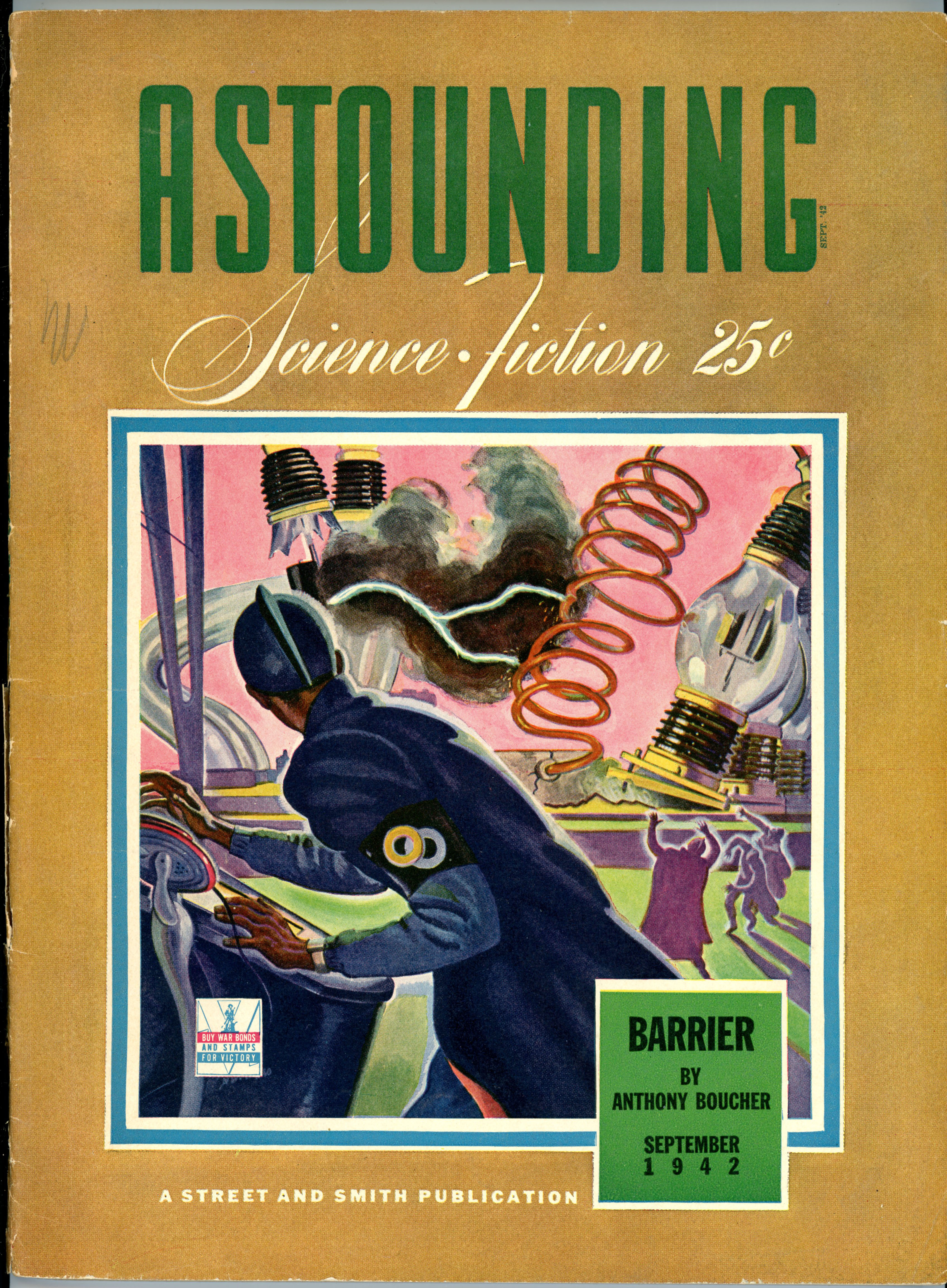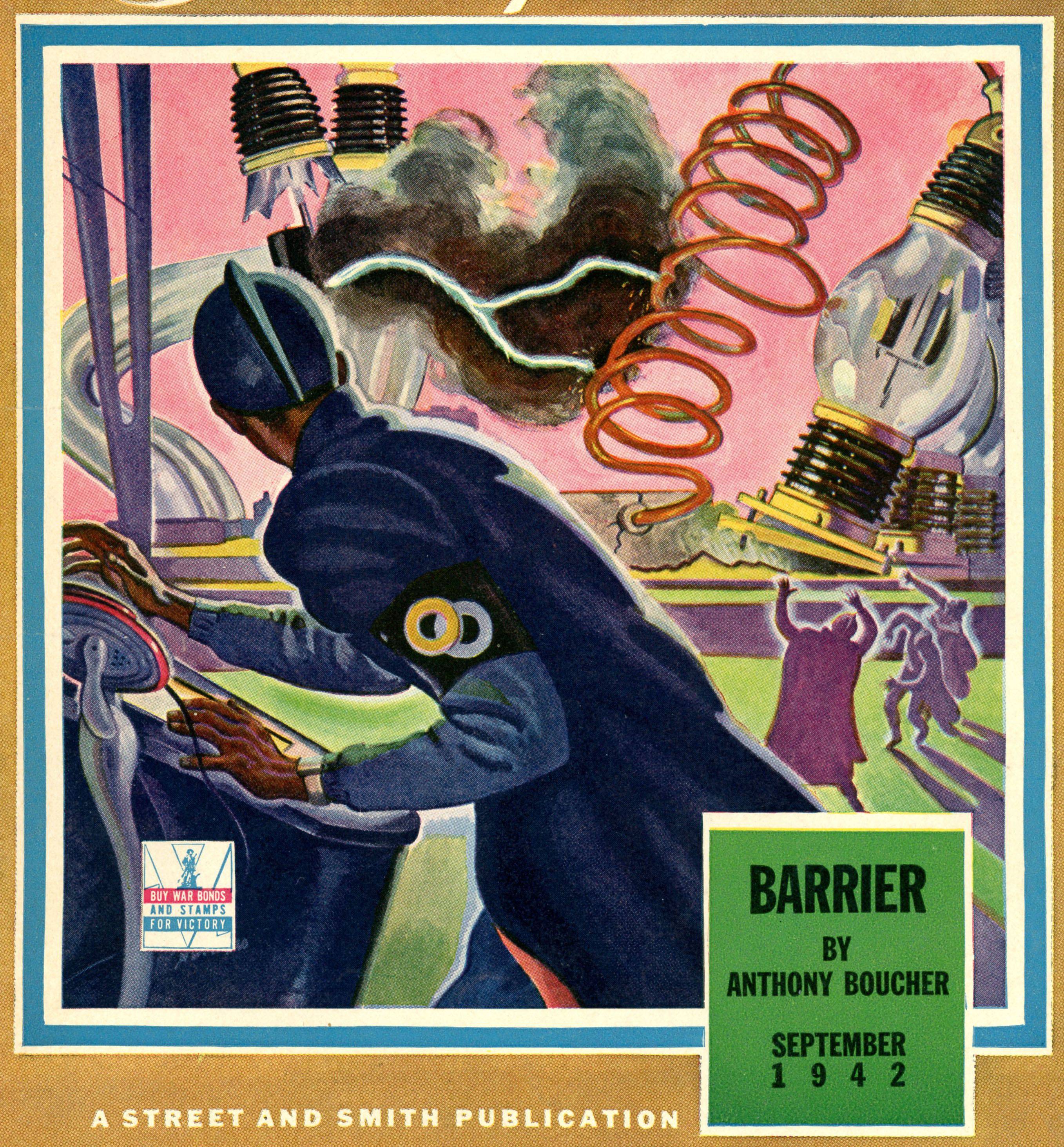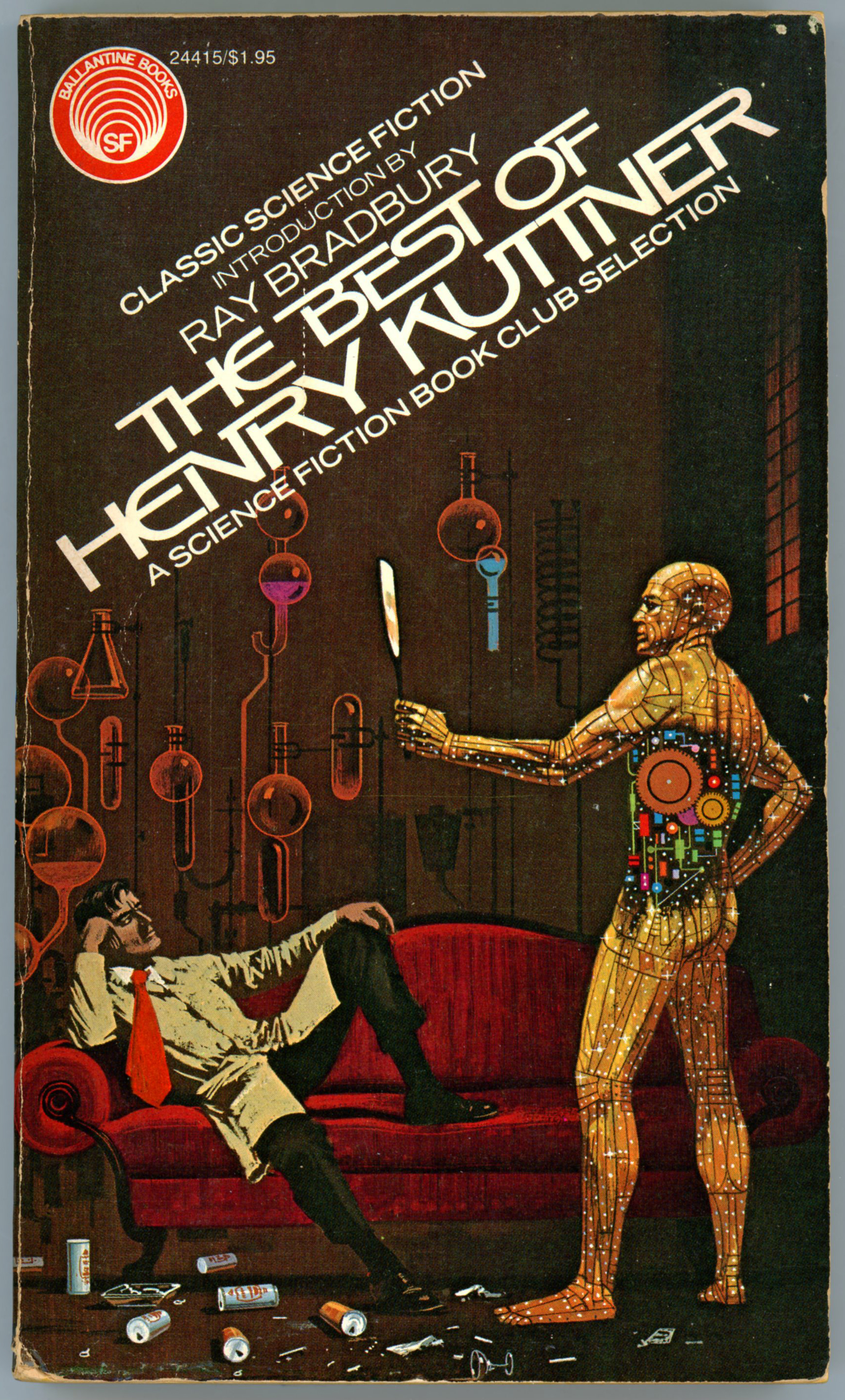Whatever the truth of the hackneyed expression “imitation is the sincerest form of flattery”, imitation most definitely characterizes other aspects of life: Ways of thought; similarities in the “mood” of an age, whether that mood be artistic and intellectual; technological or theatrical; parallels in language and speech. And especially, similarities in literature.
In the literature of science fiction, a striking similarity occurred from the 1970s through the 1990s, in the form of anthologies issued by two different publishing houses: Donald A. Wollheim Books, and, Ballantine Books.
Wollheim Books (for short!) took the approach, under the dual aegis of Isaac Asimov and Martin H. Greenberg, of publishing a series entitled “Isaac Asimov Presents the Great SF Stories,” from 1939 through 1963. Each book in the series – the sequential number of each volume appearing as part of its very tile – was devoted to short stories and novellas published during each successive calendar year over that twenty-five year time-frame. In effect (I don’t know about intent!) the Wollheim approach resulted in a not-so-indirect eye upon the literary and cultural development of science fiction, as it moved from the semi-eyebrows-raised / not-necessarily-in-polite-company / harrumph! periphery of culturally acceptable literature to (well, by 1963) its increasing and open acceptance by the general public. And even; and eventually, beyond.
Ballantine Books chose a different approach.
From 1974 through 1995, that company published its own set of anthologies, under the series title “Ballantine’s Classic Library of Science Fiction”, albeit the “header” on the cover page of each book simply used the verbiage (in rather small font, at that) “Classic Science Fiction”. Rather than approach the genre on a year-by-year, stylistic, or topical basis, Ballantine chose to allocate each of its books to the stories of one author only, eventually resulting in anthologies of the works of 22 writers. Most volumes included about sixteen stories, with a “low” of 11 for the works of Catherine L. Moore and Hal Clement, all the way up to 31 (!) for Fredric Brown. Given that the books were generally of the same length – from 350 to 400 pages – these “story counts” were an indirect reflection of the authors’ writing styles. Some writers preferred to pack a “punch” into relatively few(er) pages, while for others – like the extraordinarily talented Catherine Moore or the uncannily imaginative Cordwainer Smith, both of whose creativity equaled their originality (or was it the other way around?) – the power of a tale remained undiminished throughout the entirety of its text.
Unlike the approach of Wollheim, with Asimov and Greenberg being dual editors / commentators for every volume of the “Isaac Asimov Presents…” series, Ballantine presented their books’ contents in a way that was ultimately far more expressive, creative, and therefore less rote. Regardless of whether each book’s stories were selected by the actual author of the stories within it (some authors, like John W. Campbell, Jr., and Cyril Kornbluth having passed away years before), each volume included an introduction and overview by an already-established author of science fiction, who approached the subject author’s collected work from vantages literary, cultural, and especially biographical. In some books, every story is prefaced by a brief but substantive blurb about the literary origins or cultural context of the tale, while other books (like that devoted to stories by Henry Kuttner – check it out below…) are bereft of any “intros” at all. In at least one book, that devoted to the wonderful tales of the aforementioned Cordwainer Smith (Paul M. Linebarger), the introduction is preceded by a diagram of the timeline of the “universe” created by the author, a touch utterly unlike the Wollheim series.
Having read every book in the Wollheim series, and some of the Ballantine series, I think that Ballantine’s approach was better. Though the commentary by Asimov and Greenberg was – welllll, I’ll be charitable – en-ter-tain-ing as it were – the presence of introduction and commentary by different, recognized writers, each with their own perspective, writing style, and “world-view”, lent to the Ballantine volumes a deeper, more solid, and substantive literary and historical “heft” – by far – than the Wollheim series. Within the latter, Asimov’s and Greenberg’s lightly humorous introductions and comments became – as you moved through the series – as predictable as they were empty. (Entirely consistent with the shallowness of most of Asimov’s fiction. But, that’s another topic…)
As for the cover art of the Ballantine series? That, too, took a different approach from the Wollheim series. For every book in the Ballantine series, the cover art occupied the entirety of the cover. For the Wollheim series, the books started with “full” cover art, switched to small illustrations set within a solid color background, and for the last eleven books in the series, returned to full cover art.
So…
Like the post about the Wollheim series, “this” post summarizes the publishing history of the Ballantine series, all titles of which, arranged alphabetically by author’s surname, are listed below. After the title, you’ll see the name of the introductory author, date of publication, name of cover artist, cover price, Ballantine or Del Rey-Ballantine book serial number, and ISBN. Whew. (Those books for which I’ve already created posts are linked, as well.)
Here they are:
The Best of James Blish, Robert A.W. Lowndes, August, 1979 (H.R. Van Dongen), $1.95, 25600 / 0-345-25600-X
The Best of Robert Bloch, Lester Del Rey, November, 1977 (Paul Alexander), $1.95, 25757 / 0-345-25757-X
The Best of Leigh Brackett, Edmond Hamilton, September, 1977 (Boris Vallejo), $1.95, 25954 / 0-345-25954-8
(Republished June, 1986 (Boris Vallejo), $3.95, 33247 / 0-345-33247-4)
The Best of Fredric Brown, Robert Bloch, May, 1977 (H.R. Van Dongen), $1.95, 25700 / 0-345-25700-6
The Best of John Brunner, Joe Haldeman, November, 1988 (Barclay Shaw), $3.95, 35307 / 0-345-35307-2
The Best of John W. Campbell, Jr., Lester Del Rey, June, 1976 (H.R. Van Dongen), $1.95, 24960 / 0-345-24960-7
(Republished February, 1995 (H.R. Van Dongen) $5.99, 24960 / 0-345-24960-7)
The Best of Hal Clement, Lester Del Rey, June, 1979 (H.R. Van Dongen), $1.95, 27689 / 0-345-27689-2
The Best of L. Sprague de Camp, May, 1978 (Darrell Sweet), $1.95, 24574 / 0-345-25474-0
The Best of Lester del Rey, Poul Anderson, September, 1978 (H.R. Van Dongen), $1.95, 27336 / 0-345-27336-2
The Best of Philip K. Dick, John Brunner, March, 1977 (Vincent Di Fate), $1.95, 25359 / 0-345-25359-0
(Republished March, 1978 (Vincent Di Fate), $1.95, 25359 / 0-345-25359-0)
The Best of Raymond Z. Gallun, J.J. Pierce, August, 1978 (H.R. Van Dongen), $1.95, 25273 / 0-345-25273-X
The Best of Edmond Hamilton, Leigh Brackett, August, 1977 (H.R. Van Dongen), $1.95, 25900 / 0-345-25900-9
The Best of C.M. Kornbluth, Frederick Pohl, January, 1977 (Dean Ellis), $1.95, 25461 / 0-345-25461-9
The Best of Henry Kuttner (this post!), Ray Bradbury, April, 1975 (Dean Ellis), $1.95, 24415 / 0-345-24415-X
The Best of Fritz Leiber, Poul Anderson, September, 1979 (Michael Herring), $2.25, 28351 / 0-345-28351-1
The Best of Murray Leinster, J.J. Pierce, April, 1978 (H.R. Van Dongen), $1.95, 25800 / 0-345-25800-2
The Best of C.L. Moore, Lester Del Rey, March, 1976 (Tim and Greg Hildebrandt), $1.95, 24752 / 0-345-24752-3
(Republished, December, 1980, $2.25, 28952 / 0-345-28952-8, and…
January, 1981, $2.25, 28952 / 0-345-28952-8,
…both covers by Tim and Greg Hildebrandt)
The Best of Frederik Pohl, Lester Del Rey, April, 1976 (Dean Ellis), $1.95, 24607 / 0-345-24507-5
The Best of Eric Frank Russell, Alan Dean Foster, October, 1978 (H.R. Van Dongen), $1.95, 27700 / 0-345-27700-7
(Republished July, 1986 (Barclay Shaw), $3.95, 33223 / 0-345-33223-7)
The Best of Cordwainer Smith, J.J. Pierce, September, 1975 (Darrell Sweet), $1.95, 24581 / 0-345-24581-4
(Republished October, 1977 (Darrell Sweet), $2.25, 27202 / 0-345-27202-1)
The Best of Stanley G. Weinbaum, Isaac Asimov, June, 1974 (Dean Ellis), $1.65, 23890 / 0-345-23890-7
(Republished January, 1979 (Dean Ellis), $1.95, 27965 / 0-345-27965-4)
The Best of Jack Williamson, Frederik Pohl, June, 1978 (Ralph McQuarrie), $1.95, 27335 / 0-345-27335-4
________________________________________
Here’s the cover of the first published volume in the series and the inspiration for this post: The Best of Henry Kuttner, with Dean Ellis’ cover illustration inspired by the story “The Proud Robot”. All stories in this volume were co-authored with Kuttner’s wife Catherine L. Moore, except for “The Proud Robot”, “Misguided Halo”, “The Voice of the Lobster”, and, “The Big Night”.
Mimsy Were the Borogoves, from Astounding Science Fiction, February, 1943
Two-Handed Engine, from The Magazine of Fantasy and Science Fiction, August, 1955
The Proud Robot, from Astounding Science Fiction, October, 1943
The Misguided Halo, from Unknown, August, 1939
The Voice of The Lobster, from Thrilling Wonder Stories, February, 1950
Exit the Professor, from Thrilling Wonder Stories, October, 1947
____________________
The Twonky, from Astounding Science Fiction, September, 1942
Here’s the cover of the September, 1942, issue of Astounding…
 …and, a close-up of William Timmins’ cover art. Giant light-bulbs a-bursting? Well, it gets the point across!
…and, a close-up of William Timmins’ cover art. Giant light-bulbs a-bursting? Well, it gets the point across!
 The film adaptation of “The Twonky” (1953) can be found at Ayako Edwina’s YouTube channel.
The film adaptation of “The Twonky” (1953) can be found at Ayako Edwina’s YouTube channel.
____________________
A Gnome There Was, from Unknown Worlds, October, 1941
The Big Night, from Thrilling Wonder Stories, June, 1947
Nothing But Gingerbread Left, from Astounding Science Fiction, January, 1943
The Iron Standard, from Astounding Science Fiction, December, 1943
Cold War, from Thrilling Wonder Stories, October, 1949
Or Else, from Ahead of Time, 1953
Endowment Policy, from Astounding Science Fiction, August, 1943
Housing Problem, from Charm, October, 1944
____________________
What You Need, from Astounding Science Fiction, October, 1945
The basis of the identically-titled episode 12 of The Twilight Zone, first broadcast on December 25, 1959, profiled at the Internet Movie Database, “What You Need” is the subject of Twilight Tober-Zone’s critique, which also covers Tales of Tomorrow’s 1952 version of the story.
Absalom, from Startling Stories, Fall, 1946
____________________
References and What-Not
Publication History of Ballantine Books / Del Rey-Ballantine, “The Best of…” science fiction series, via Internet Speculative Fiction Database
Library of Congress Online Catalog (Advanced Search)
Biography of Dean Ellis, at askArt
Works by Dean Ellis, at Science Fiction Book Art
Works by Dean Ellis, at Artnet

